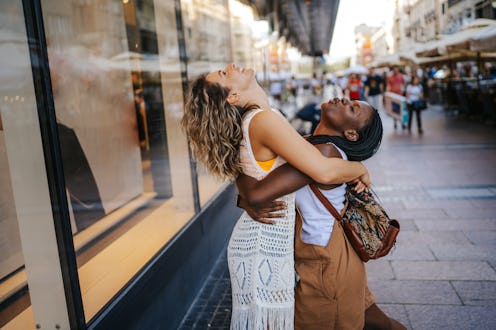Wellness
When Will Everything Go Back To Normal?
Plus, what normal even means post-pandemic.

A year on, the COVID pandemic has changed basically everything: first dates, Zoom etiquette, the working world, how much Netflix in a day is reasonable. After 12 long months, you're likely longing for the end — a return to the way things used to be, when going to the store didn't involve a cost-benefit analysis, two masks, and four dollops of hand sanitizer. The vaccine rollout means that something resembling the Before Times might be coming. But experts tell Bustle that figuring out when post-pandemic life will be back to normal is hugely difficult — if it comes back at all.
When We'll Know Things Are Back To Normal
Dr. Anthony Fauci, M.D., director of the National Institute of Allergy and Infectious Diseases, told CNN on Feb. 21 that it was impossible to predict when "normal" life might return, and that many people will likely still be wearing masks into 2022. For experts, predicting the end of the pandemic involves very tricky number-crunching.
"It will be difficult to come up with a purely mathematical rubric for what is 'normal'," Professor John Sellick D.O. from the Department of Medicine at the University of Buffalo's Jacobs School of Medicine and Biomedical Sciences, tells Bustle. Anybody who's attempting to pinpoint the return of "normal" life, he says, will be looking for decreasing hospital cases, percentage of positive tests, and falling numbers of hospitalizations and deaths. These metrics show governments when it's safe to open up schools, restaurants, movie theaters, and more, and whether or not municipalities require mask usage. (Though, of course, these regulations vary wildly state to state.)
Pre-pandemic life might return when the population reaches herd immunity — that is, when enough people carry antibodies to COVID that it's very hard for it to be transmitted, which is thought to be around 80% of the population. "We are above 10% of the population being vaccinated (and many more each day) along with almost 30 million people having had the coronavirus, which translates into more than 20% of the population having some level of immunity," Dr. Teresa Bartlett M.D., senior medical officer at claims management company Sedgwick, tells Bustle. With news that some vaccines can actually stop COVID from transmitting as well as protecting people from catching it, herd immunity may be coming more quickly than anticipated.
But Professor Sellick urges caution, because the picture involves many moving parts. "The process will be gradual, and there is not a magic number at which we can declare herd immunity," he says. "As we see these case numbers and look at them in conjunction with antibody test positives, percentage of the population immunized, and so on, we will have a much better idea of where we stand." Dr. Kathleen Jordan M.D., senior vice president of medical affairs at Tia, tells Bustle that schools reopening with very little reported transmission of COVID are also a good sign of returning normalcy.
Low case numbers, low numbers of positive tests, a high proportion of vaccinated people, and plummeting numbers of hospitalized patients: all those factors need to combine in order for indoor activities to reopen, social distancing requirements to be lifted, and for the masks to come off.
What "Normal" Might Look Like
Even once pandemic-related restrictions are lifted, what's normal in 2021 or 2022 may look totally different from what was considered "normal" pre-pandemic.
Over half a million Americans have now died from COVID, and the virus is unlikely to ever fully disappear. "It will become one of the circulating respiratory viruses of humans, but as long as we have high-quality vaccines, we hopefully will prevent the carnage of the past year," Dr. Sellick says. It's hoped that COVID will become something like the flu: a problem that can be vaccinated against.
In addition, the pandemic has been traumatizing for many people, psychotherapist Dr. Lisa A. Henshaw tells Bustle. "The nature of traumatic events is that they are unpredictable, which holds true for the pandemic," she says. "No one could have predicted how long it would go on for, what it would entail to stay safe, and so on." In all that miserable uncertainty, it's understandable to cling to the idea of a return to daily routines.
Instead of a return to the way things were, Dr. Bartlett says it's more like "a good path to a new normal," where people often wear masks in the wintertime, and COVID vaccine boosters appear every year like the flu shot. Once all the indicators are at rock-bottom, though, social distancing and restrictions on indoor activities will be things of the past — hopefully. While things aren't going to be quite the same, hugs with friends are definitely on the horizon.
Experts:
Dr. Teresa Bartlett M.D.
Dr. Lisa A. Henshaw Ph.D. LCSW
Dr. Kathleen Jordan M.D.
Dr. John A. Sellick D.O.
This article was originally published on